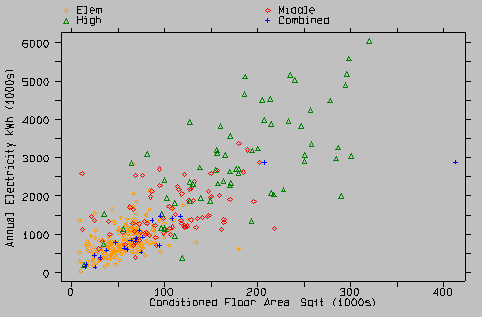
![]()
A detailed survey of energy use and related physical and operational characteristics of Florida's public schools was completed. A mailed survey instrument was sent to all 2,512 schools through out the state in March 1996. A total of 1,298 surveys were returned -- a response rate of 52%. Of these, some 680 provided matching utility data. The survey data was analyzed to create a school energy use profile as well as to identify characteristics that may influence efficiency. A typical Florida school uses 1.4 million kWh and 7,400 therms of natural gas at an annual expense of $94,000 per year (1.24 Btu/ft2). Based on our findings, the total annual energy cost for the Florida school system totaled $205 million in 1995.
The objectives of this study were:
- To develop detailed information on the characteristics of Florida schools
which might have energy implications.
- To develop ranking of schools based on relative energy use.
- To analyze the statistical association of school characteristics
and energy use.
The principal yardstick used in this analysis is that of energy used per square foot of air conditioned floor area, or Energy Use Index:
EUI = Annual Energy Use (kBtu) / Facility Floor Area (ft2)
This measure allows comparison of schools to determine those with the largest opportunities for savings.
We ranked schools with complete data (654 facilities) by their energy use per square foot, or Energy Use Index (EUI, kBtu/ft2). The EUI's varied from 2 - 226 kBtu/ft2. The 10% of schools who used the most energy per square foot were identified as potential candidates for future improvement projects.

Histogram of energy use index (EUI) for all schools
Finally, an analysis was performed of the statistical influences on energy use in schools based on the responses to the survey questionnaire against the matched utility data. The analysis showed some surprising influences:
- Floor area and number of students and faculty were significant factors increasing annual energy use. High schools, Middle schools and vocational schools used more than elementary schools. Portable classrooms increased annual energy use by approximately 10,800 kWh.
- Schools conditioned on non-school days and those with central thermostats used more energy. Schools with manual lighting and clock thermostat controls used less. Cooling set points were important.
- Classrooms with windows used 18% less energy than those without them. This may be due to reduced need for interior lighting, available ventilation or both.
- Schools with light colored roofs used 7% less annual energy.
- Schools relying predominantly on packaged cooling equipment rather than central chillers used 24% less energy.
- Schools with a history of humidity problems tended to use more energy. Complaints of indoor air quality (IAQ) and humidity problems were strongly related.
- Schools using windows for ventilation reported significantly lower IAQ concerns although schools with higher cfm ventilation per student showed lower incidence of IAQ problems.
- Facilities with ceiling fans in classrooms showed substantially reduced energy needs and higher cooling set point temperatures.
- Schools with demand controlled ventilation used more energy on an annual basis.
- Low temperature air distribution systems showed no significant reduction to annual energy costs or monthly peak demand and were associated with increased complaints of indoor air quality and humidity problems. These systems were also associated with the largest increases to annual normalized energy use of all identified survey characteristics.

Relationship of annual electricity use to floor area by school type
Issues statistically linked to perceived indoor air quality problems:
- 53% complained about excess indoor humidity (complaints increased with grade level elementary = 57%; middle = 60%; senior high = 72%)
- 59% perceived problems with IAQ (excess humidity/ poor iaq strongly linked; greater ventilation rate (cfm/student) = greater problems)
- Operable windows were very important.
- Full Publication: FSEC-CR-951: Energy Efficiency for Florida Educational Facilities: The 1996 Energy Survey of Florida Schools
